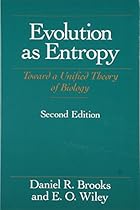Evolution As Entropy: Toward a Unified Theory of Biology (Science and Its Conceptual Foundations series)

| Author | : | |
| Rating | : | 4.54 (729 Votes) |
| Asin | : | 0226075745 |
| Format Type | : | paperback |
| Number of Pages | : | 429 Pages |
| Publish Date | : | 2016-12-02 |
| Language | : | English |
DESCRIPTION:
Robert Paustian, Wilkes Coll. Lib., Wilkes-Barre, Pa.Copyright 1985 Reed Business Information, Inc. Not easy going for the casual reader, but well worth the effort for others. They support their difficult yet logical arguments with a wide range of examples taken from developmental biology, embryology, morphology, population genetics, systematics, and community ecology. From Library Journal This serious and scholarly tome unites the theory of biological evolutioni.e., that biological systems tend to become more ordered and highly structured through evolutionary timewith the seemingly contradictory second law of thermodynamicsi.e., that disorder or entropy increases over time. . Recommended
Daniel R. Brooks is associate professor of zoology at the University of Toronto. Wiley is professor in the Department of Systematics and Ecology and curator at the Museum of Natural History at the University of Kansas.. E. O
It fortifies the place of Evolutionary Theory among the other well-established natural laws."—R.Gessink,TAXON. Hailman, Animal Behaviour, review of the first edition"An important contribution to modern evolutionary thinking. I found it to be challenging, fascinating, infuriating, and provocative, but certainly not dull."—James H, Brown, University of New Mexico"This book is unquestionably mandatory reading not only for every living biologist but for generations of biologists to come."—Jack P. "By combining recent advances in the physical sciences with some of the novel ideas, techniques, and data of modern biology, this book attempts to achieve a new and different kind of evolutionary synthesis
Tim Tyler said An unsuccessful early attempt to unite biology and physics. These are exciting times for science. One recent development involves a unification between physics and biology - in particular between the maximum entropy principle of thermodynamics and a generalized version of Darwinian evolution. This unites fundamental principles in the realm of science that covers living systems with different principles in the science that covers inorganic dissipative structures.Attempts to integrate Darwinian evolution with thermodynamics have been going on for a while. One notable attempt can be found in the book "Evolution as Entrop. Seminal and thought provoking; I highly value this book This is a very technical book, but it was well worth the effort for me. I first read it 8 years ago, and I still re-read it about once a year to ponder the implications. It is a refreshing, challenging, and potentially revolutionary view of evolution. While it may not prove to be the final understanding of this topic, it is a solid attempt to provide a thermodynamic underpinning for the law of Evolution.It contains 2 profound and provocative hypotheses:1) Information stored in living creatures' DNA can be modeled as a hierarchy of information stored at the di. "A blizzard" according to A Customer. of mathematical equations from information theory with little or no physical substance. One of the authors (Brooks) appears to be a misplaced mathematician who formally became a zoologist. It should be remembered that General Relativity was first submitted for publication by a mathematician (Hilbert) ahead of a physicist (Einstein) by a matter of weeks (but essentially by theft from Einstein, being a former mentor of Einstein)and dismissed in favour of the physicist as lacking any physical insights.The late Volkenstein succintly criticized the book in his out
